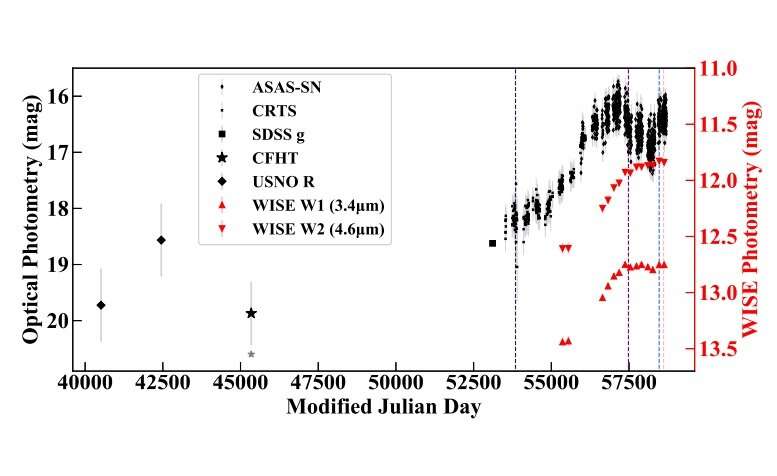November 10, 2020 report
New extremely variable quasar discovered

By analyzing data from astronomical surveys, Japanese astronomers have detected a new, extremely variable quasi-stellar object (QSO), or quasar. The newly found object, designated SDSS J125809.31+351943.0, brightened in optical band for 4.0 mag over three decades, which means that it was one of the largest quasar brightening events so far recorded. The finding is reported in a paper published November 3 on arXiv.org.
Quasars are active galactic nuclei of very high luminosity, emitting electromagnetic radiation observable in radio, infrared, visible, ultraviolet and X-ray wavelengths. They are among the brightest and most distant objects in the known universe, and serve as fundamental tools for numerous studies in astrophysics as well as cosmology. For instance, quasars have been used to investigate the large-scale structure of the universe and the era of reionization. They also improved our understanding of the dynamics of supermassive black holes and the intergalactic medium.
Some distant quasars exhibit broad emission lines (BELs) that appear or disappear, which is known as a so-called optical "changing-look" phenomenon. Most of these changing-look quasars (CLQ) showcase large optical luminosity variations exceeding 1.0 mag. Besides CLQs, such large luminosity changes have been also observed in hyper-variable quasars (HVQs) and changing-state quasars (CSQs). The classification of HVQs is based on the change of optical brightness, while that of the CSQ is on the change of BELs, optical continuum flux density and mid-infrared luminosities.
Now, a team of astronomers led by Shumpei Nagoshi of the Kyoto University in Japan reports the finding of a new quasar that exhibits a large amplitude of variability and appears to be a CSQ. The discovery of SDSS J125809.31+351943.0 (or J1258 for short) was based on data from programs including the Survey and All Sky Automated Survey for Super Novae (ASAS-SN), the Sloan Digital Sky Survey (SDSS) and NASA's Wide-field Infrared Survey Explorer (WISE).
"We discovered an extremely variable quasar, SDSS J125809.31+351943.0, brightened for 4.0 mag from 1983 to 2015. We identified this object as a new CSQ on the basis of the significant changes in the mid-infrared luminosity and in the intensity of the broad emission line," the astronomers wrote in the paper.
The observational data span the period between 1983 and 2015. It was found that J1258 exhibited a monotonic increase of luminosity for as much as 4 mag over about 30 years. The astronomers noted that this is one of the largest amplitudes of monotonic variations with the longest timescale of any quasar's variability reported to date.
Furthermore, the observations revealed significant changes in the mid-infrared luminosity and in the intensity of the broad emission line of J1258. The results also show the weakness of radio emission, which indicates that the variability is not caused by the quasar's jet. In addition, it was found the flux in mid-infrared changed following the optical band. This supports the assumption that the accretion disk itself changed, rather than the variation of absorption, took place.
The astronomers therefore concluded that J1258 is a CSQ and also one of the most drastically variable objects so far detected.
More information: Nagoshi et al., Discovery of a new extreme changing-state quasar with 4 mag variation, SDSS J125809.31+351943.0, arXiv:2011.01127 [astro-ph.GA] arxiv.org/abs/2011.01127
© 2020 Science X Network


















